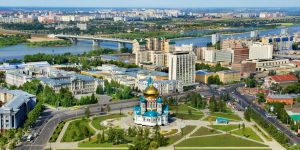
Omsk is one of the largest cities in Russia, located at the confluence of the Irtysh and Omi rivers, a large scientific, cultural, sports and industrial center. It is also known as the City of Labor Glory. Omsk is the million-plus city with 1,164,815 people according to the 2019 census. The data makes it the second most populous in Siberia and the eighth in Russia. It was founded in 1716 and officially received the status of a city in 1782 and the capital of the Russian state (1918-1920) and the administrative center of the Omsk region since 1934. The long history of the city dubs it as one of the witnesses of Russia’s journey in the past.
Omsk in a Nutshell
The location of Omsk has been of great importance since ancient times. It housed the settlements and cemeteries of few developed nations, who lived from the 6th millennium BC according to the 13th century archive. In the 17th century, the need for a Russian city at the mouth of Omi was so great that the Tsar was repeatedly asked for its foundation. Omsk was founded by I. D. Buchholz in 1716 as a fortress protecting the southern borders of the state. The city received its main development in the 20th century: it was the capital of the State of the Russian (White Russia) in 1918 to 1920, and expanded significantly during the Great Patriotic War. Many factories from the European part of Russia were moved to the city, and before the collapse of the Soviet Union, the city was known as “Garden City”, “City of Youth”, and “City of Science”.
The History of Omsk
The city of Omsk was founded in 1716. The history of Omsk began since almost 300 years ago. By order of Peter I, Lt. Col. Buchholz with a detachment of soldiers and Cossacks landed at the mouth of Omi and founded a fortress there, which became known as Omsk. This fortress was built to protect Siberia from nomads.
Omsk has officially existed for more than 50 years. In 1768-1771, at the initiative of the commander of the Siberian Corps, General I. I. Springer, a new fortress was built on the right bank of the Omi with more advanced protective engineering structures. In August 1782, the Omsk fortress became one of the ten district settlements of the Tobolsk governorate, and in October of the same year it was given the status of a city.
An important event in the history of Omsk was the creation, in 1822, of two independent governor-generals on the territory of Siberia: the West Siberian and East Siberian. It was Omsk that was elected the permanent residence of the Governor General. At the same time, the Governor General made a petition to the government to transfer the Main Directorate of Western Siberia from Tobolsk to Omsk, as a result of which Omsk became practically the main city of Western Siberia with the subordination of the Tobolsk, Tomsk provinces and Semipalatinsk region.
The construction of the Trans-Siberian railway served as a powerful impetus for the development of the region, due to which Omsk became a major transport center having a favorable geographical position at the crossroads of the Irtysh River and the continental railway. In March 1896, a bridge was built across the Irtysh and train traffic began from Chelyabinsk to Novonikolaevsk (Novosibirsk). At the end of the 19th century and the beginning of the 20th century, Omsk noticeably changes its former appearance, turning into one of the industrial and socio-cultural centers of Western Siberia.
At the beginning of the 20th century, new multi-story buildings of classical architectural forms started to appear in Omsk. This, for example, is the building of the Treasury Chamber and the Provincial Treasury, erected by the project of architect N.E. Varaksin in 1900. In 1903 Moscow shopping arcades were built on Chernavinsky (Lubinsky) Avenue as a project of architect O.V. Dessin. In 1905, the construction of a drama theater was completed on the same street by the architect I. Khvorinov. Across the theater in 1914, according to the project of architect A. Kryachkov, the building of the city commercial was built. A court house, the Railway Administration and other buildings were then continued to be built, giving Omsk a unique look.
After October 1917, the city became the political center for the establishment of Soviet power in Western Siberia. In the period from June 1918 to November 1919, the city of Omsk was the residence of the Supreme Ruler of Russia, and Admiral A.V. Kolchak declared Omsk as the capital of Siberia. In 1934, the Omsk province was formed, and the city of Omsk became its center.
Omsk Today
Omsk is considered as the third capital of Russia. The origins of this idea lie in the importance of Omsk as the administrative center of the Steppe Territory, connecting the North Siberian and the West Russian with the steppe south and east from the 18th century. It was a border town, an important transportation hub. Nevertheless, the idea that Omsk is worthy to be a special city is spreading more and more in modern times, especially among young people. Various epithets of a similar kind arise; for example, the organizer of Battle Social Dance, Marina Kopylova, called it “the third dance capital”, and because of the abundance of theaters, Omsk is described as the “theater capital of Siberia”. There is also an Omsk socio-political weekly “The Third Capital”. Despite this, the patent for the use of the Third Capital trademarks and analogues in 2009 was issued by Rospatent to another city – Kazan. However, the long and rich history of the city will always become one of the witnesses to Russia’s journey in the past.
